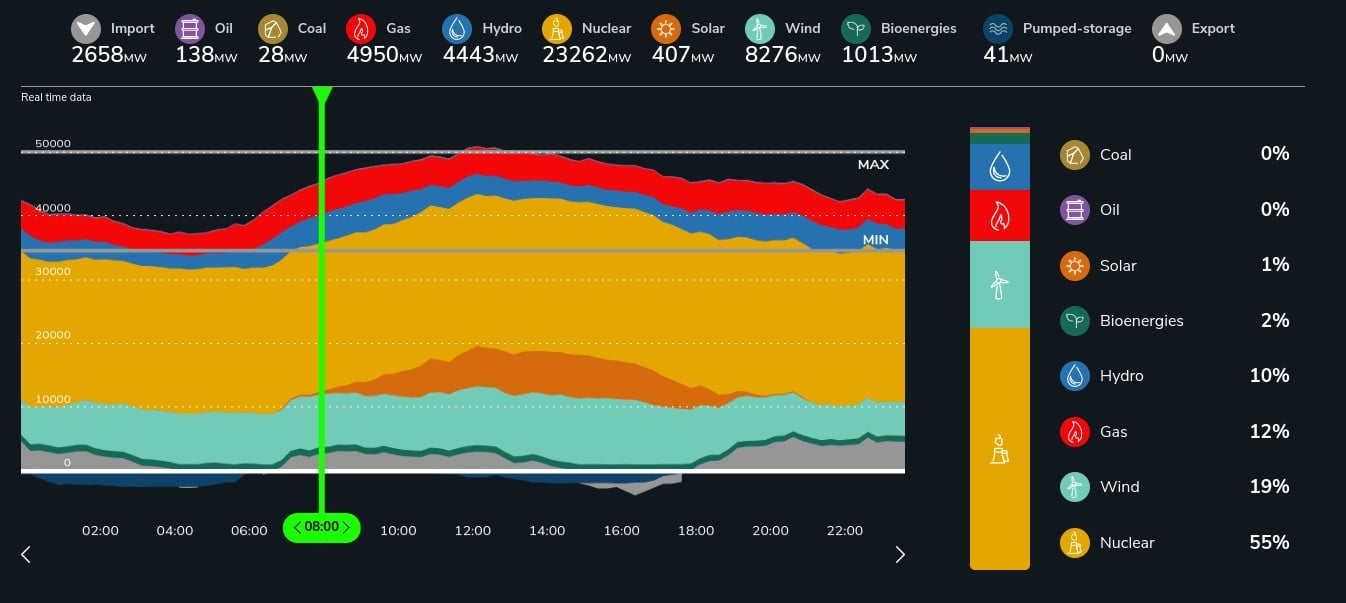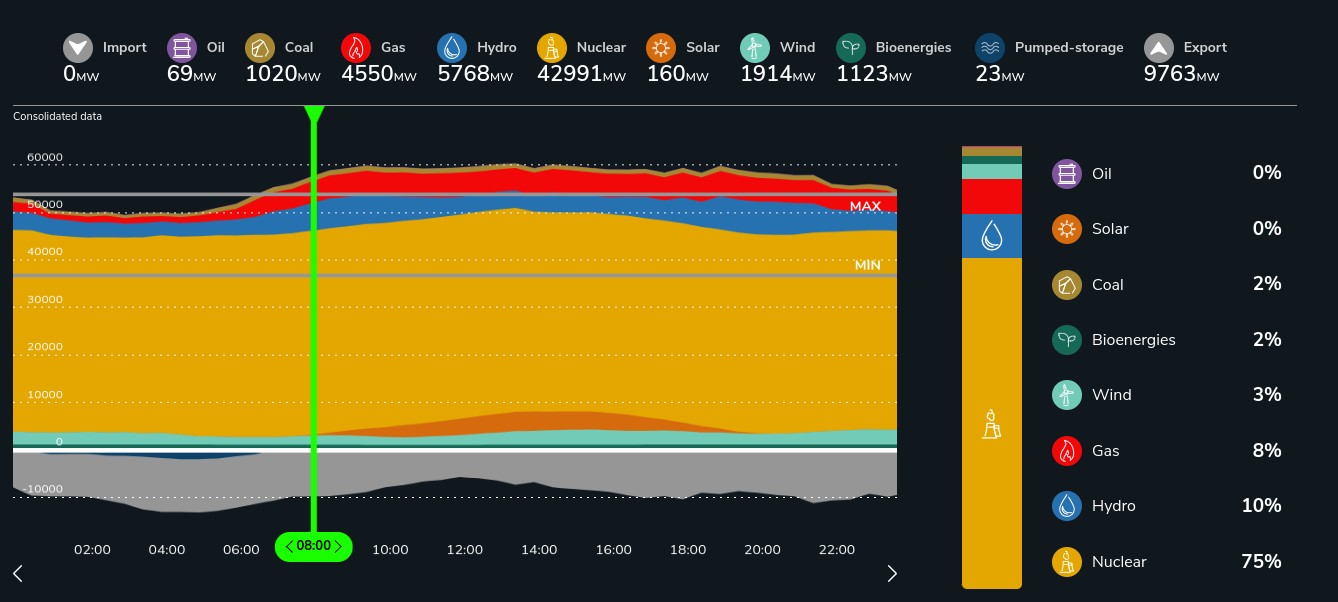u
Cannot be. France power generation mostly from nuclear power plants.
unbelievable isn't it?
frog eaters facing problem with their nuclear power plants and also strikes, all in all, great news.
Energy shortages: What’s the problem with France’s nuclear industry?
As Europe prepares to face a winter without Russian gas, France should be in a better position than most thanks to its large domestic nuclear industry - but a series of problems with French nuclear plants has led to a power shortage.
Published: 12 September 2022 14:48 CEST
Updated: 12 September 2022 15:53 CEST
An operator works in the control room at the nuclear power plant in Flamanville, Normandy Photo by Sameer Al-DOUMY / AFP
France usually produces around 70 percent of its electricity from nuclear, and is at most times a net exporter of electricity. It does import gas – in 2021, 17 percent of France’s gas came from Russia – but overall the country is one of the more self-sufficient in Europe when it comes to energy.
That should in theory mean that it is in a good position to get through the winter without Russian gas, since Russian supplier Gazprom appears to have turned off pipeline supplies to Europe, apparently in retaliation for EE sanctions imposed after its invasion of Ukraine in February.
France has managed to almost entirely fill its gas reserves, and also arrange gas supply deals with other countries, but a series of problems with the country’s nuclear power plants mean that electricity production has dipped sharply, leaving France having to import part of its electricity.
Although the situation is not as bad as in other countries such as neighbouring Germany, the French government is working on a plan for
sobriété energétique (energy sobriety) to cut the country’s energy usage by 10 percent, the amount judged necessary to avoid any kind of energy rationing this winter, even if the winter is exceptionally cold.
READ ALSO Will there be energy rationing in France this winter?
So what’s gone wrong with French nuclear?
The French electricity distributor RTE
publishes real-time data showing where France’s electricity comes from – on Friday at 8am this showed 23,262 MW of power produced by nuclear, making up 55 percent of France’s total, with the rest made up by wind (19 percent) gas (12 percent) hydro (10 percent), biofuels (2 percent) and solar (1 percent). France did not export any energy that day and instead imported 2658 MW.
Energy production in France on September 9th 2022. Data: rte-France.com
One year ago – on September 9th 2021, France was not importing any power and exported 9763MW. On that day at 8am, 75 percent of electricity produced in France came from nuclear, with 42,991MW produced in total from French nuclear plants. The rest was made up of hydro (10 percent) gas (8 percent) wind (3 percent) biofuels (2 percent) and coal (2 percent)
Energy production in France on September 9th 2021. Data rte-france.com
Several factors account for the sharp fall in production;
Hot summer
France has had an exceptionally hot summer –
the second hottest on record – and this affects nuclear plants because of the cooling process.
Nuclear plants require large amounts of water to keep the reactors cool, and many French plants are build next to rivers to ensure a steady supply of water. However France’s exceptionally hot summer has led to drought conditions on many rivers, meaning that water supply has been limited and therefore the plants have had to limit their consumption.
If river water rises above a certain temperature it is also less effective for cooling, meaning that plants have to limit production.
Although the summer heatwaves have largely subsided, large parts of France are still on drought alert with normal conditions not expected to reappear until October.
Closures
But it’s not just a case of lower production rates – many of France’s nuclear power plants are not producing anything at all right now.
Exact figures vary according to the day, but
around half of France’s 56 nuclear reactors have been closed at any one time over the last few months.
READ ALSO: OPINION: France cannot afford to keep shielding consumers from energy price rises
Some of the closures are planned short-term closures to allow routine maintenance and repairs, while others are longer closures.
Covid
The industry is still feeling some of the knock-on effects of Covid when routine maintenance was postponed or repairs cancelled during periods of lockdown or staff shortages, which means that nuclear plants have had a higher number of short-term closures this year than usual, as staff catch up with the backlog.
Cracks
However, there is another more serious problem – cracks. Since January, 13 plants have been subject to emergency closure because of the discovery of corrosion in the cooling pipes, which takes the form of tiny cracks (known in French as
micro-fissures), some so small as to be invisible to the naked eye.
The majority of the cracks have been found in the emergency cooling systems for the plants, which must be ready to be used at any time to cool the reactor in an emergency situation.
This doesn’t necessarily mean that the plants are unusable, but it requires urgent and non-planned maintenance to repair any areas showing signs of corrosion and production cannot restart until this work is done since, for obvious reasons, nuclear plants have very tight safety standards.
The majority of the cracks have been found at France’s older plants and although it is a known issue in the nuclear industry, French experts are concerned that in some plants it has happened earlier than anticipated.
Edf has launched a full inspection of all its plants, and the French government and Edf say that all plants where corrosion has been discovered will be back operating at full capacity by February.
So what is the French government doing about this?
Short-term solution
The short-term solution is obviously to fix the cracks, and Edf says this will be done, and the maintenance backlog caught up, by February, hopefully in time for the coldest part of the year.
The second step is to reduce energy use by 10 percent this winter – to cope with both reduced electricity supply and the shortage of Russian gas. The government says that this will ensure no need for any type of energy rationing, even if it is an exceptionally cold winter. The plan will also form the part of a longer-term strategy to cut energy use by 30 percent by 2030, in order to tackle climate change.
Long-term solution
The question of how France produces its power has been a contentious political issue for some time, with both Emmanuel Macron and his predecessor François Hollance trying to step back from nuclear power.
The country’s coal-fired power stations have all been closed, the last once earlier this year, although there is now the option to re-start it if necessary this winter.
Macron in 2018 announced plans to close several of the country’s older nuclear power stations too, with the aim of increasing renewables such as wind, solar and hydro energy.
However France has lagged behind other European countries in its renewables sector, with the first ever offshore wind farm only opening in 2022, decades after other European countries, and onshore wind farms become a political issue in the 2022 election campaign as far-right leader Marine Le Pen
vowed to block new development and tear down existing ones, if she was elected.
Since 2018, Macron seems to have rowed back on his aim of cutting nuclear production, several times speaking in support of France’s nuclear energy both for environmental reasons and reasons of “energy sovereignty”.
A new nuclear plant at Flamanville – commissioned by Hollande – is due to open in 2023, more than 10 years after its scheduled opening date.
The Local
[email protected]@thelocalfrance
RELATED TOPICS













